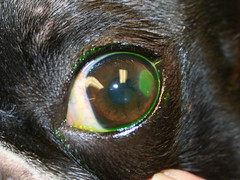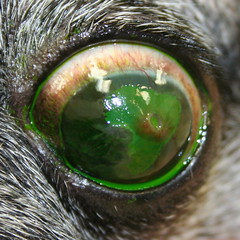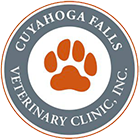|
It is not unusual for animals to have trouble with their eyes from time to time. We see many types of ophthalmic diseases, from conjunctivitis (irritation of the soft tissue surrounding the eye) to glaucoma (elevated pressure within the eye) to proptosis (eye popped out of the socket). One of the most common eye problems that we see and care for is the corneal ulcer.
The cornea is the clear, outer portion of the eye. It is protected by the tear film and the eyelids. Under normal circumstances, the tear glands around the eyes produce the tear film, both a liquid portion and a mucus portion in appropriate proportions, and as the eyelids blink, they spread the tear film evenly across the eye. Cats and dogs also have a third eyelid that can protect the eye.
Corneal ulcers occur when there is a trauma to the cornea, such as a scratch or a poke to the eye. Or they can occur when the eyelids scratch the eye when there is inadequate lubrication (a.k.a “dry eye“). Corneal ulcers must be diagnosed early and treated aggressively for this reason: the cornea is only so thick, and if an ulcer is allowed to persist, it can get deeper. The consequence of an ulcer that is left untreated can be perforation, or rupture, of the eye.
|
Ulcers are quite easily diagnosed by the veterinarians at Cuyahoga Falls Veterinary Clinic. A special stain is applied to the eye. The outer-most portion of the healthy cornea will not take up the stain, but anything under the surface will take up the stain. When the cells under the surface are exposed, a positive stain is found. As you can see in the photo here, corneal ulcers can light up like a Christmas Tree, so to speak.
Once an ulcer is diagnosed, antibiotics and a lubricant for the eye are prescribed. While steroids are used with corneal ulcers on the human side of medicine, steroids are absolutely not used with dogs and cats as this will always lead to worsening of the ulcer.
|
Sometimes corneal ulcers require more than just topical medical therapy. Sometimes they require surgery such as debridement of the edges of the ulcer, which facilitates healing. Other times procedures such as conjunctival flaps are needed to bring healthy blood supply to the lesion. In any event, corneal ulcers are not to be taken lightly, and they require vigilant treatment and strict follow-up.
If your pet has been diagnosed with a corneal ulcer, follow the directions given to you, and make sure to follow-up with your veterinarian until the diagnostic stain is negative for a defect. Your pet will thank you!







The Cuyahoga Falls Veterinary Clinic | Animal Wellness | Medical Services | Pet Services
[…] Case of the Month – Corneal Ulcer […]
The Cuyahoga Falls Veterinary Clinic | Animal Wellness | Medical Services | Pet Services
[…] Corneal Ulcer […]